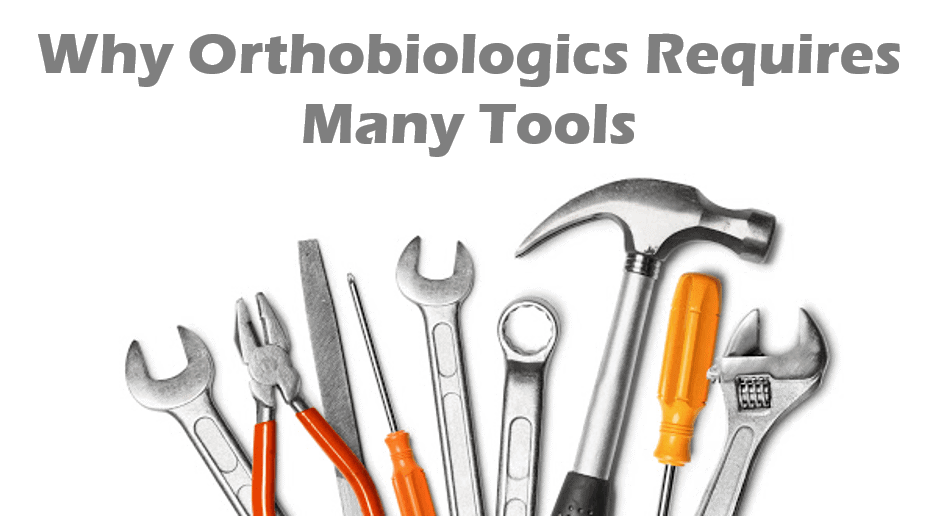Why High Quality Interventional Orthobiologics Requires Many Tools

Imagine going to a mechanic who only has one tool, let’s say a pair of pliers. That mechanic tells you he or she can do everything with those pliers including drop your engine and perform an oil change. You’d probably find some polite excuse why you needed to take your car elsewhere. However, the regenerative medicine space is filled with people who only have one or few tools. Hence, it’s time that patients get educated as to why, when they find a clinic with few tools, it’s time to politely leave and get treated elsewhere.
What Is Interventional Orthobiologics?
Interventional Orthobiologics (aka Interventional Orthopedics) is more than just performing simple joint injections but targeting specific damaged structures using imaging guidance. To see what it is and isn’t, take a minute to watch my video below:
The First Set of Tools-Imaging Guidance
Imagine just owning a flathead head screwdriver. How many times would you be frustrated by the fact that the screw you want to take out or put in is a Phillips type? That’s the same as a doctor practicing interventional orthobiologics who just owns an ultrasound machine. Why?
Ultrasound is a great tool all by itself. It can bounce soundwaves in and out of tissue so that it can provide a detailed map of the soft tissues like muscles, tendons, and ligaments. So it’s as critical a tool for someone who treats orthopedic injuries as that flathead screwdriver. However, where ultrasound totally fails is that it can’t see through bone. In that case, it’s like having a flathead screwdriver when you encounter a Phillips screw.
Here are some examples:
- Ultrasound can see superficial tendons like the rotator cuff. Fluoroscopy can’t see tendons, so while you could inject into the rotator cuff tendons with radiographic contrast to see the tendon injection using fluoroscopy, ultrasound clearly wins for this application.
- Fluoroscopy can see through bones. For example, for a disc injection, fluoroscopy can see through the vertebrae bones to show you the needle going into the disc. Ultrasound can’t see through bones, so if you tried to use ultrasound this way, while you might be barely able to see a disc by gaining a direct line of sight through a small opening between the vertebrae, the ability to image this area would be severely compromised. Hence, fluoroscopy wins for this application.
Here’s another example of why it’s critical to have both when injecting the knee:
Hence, a clinic performing IO at a high-level requires both of these tools just like you need both a flathead and Phillips screwdriver.
The Second Set of Tools-Orthobiologics
Let’s go back to our home tools example. You may have a socket set that has many different sockets that fit onto a wrench handle. The goal is to make sure that you always have the right size socket to fit every bolt that you might encounter.
Now let’s take orthobiologics. These are the things that are injected to help tissues heal like PRP and stem cells. See my video below for more information:
The problem is that we see clinics that only have one socket to offer. You know the feeling, you go to the garage to pick out a socket and find that it’s the wrong one. What’s your first response? Is there a way to make this one work? The same holds true for clinics that use orthobiologics. Let me explain.
These are the orthobiologic sockets that are available:
- Platelet-rich plasma (PRP)
- Bone marrow concentrate (BMC)
- A2M enriched plasmas
- IRAP enriched plasmas
- Micro-fragmented fat
- Birth tissues like amnion or umbilical cord
- Prolotherapy
It’s more often than not that you see clinics offering one thing like umbilical cord “stem cells”. That’s of course fiction, because if you read this blog, you know the research shows that these products have no stem cells. However, they may have helpful growth factors. But what about all of the other orthobiologic sockets? That’s why at Regenexx we offer all of these different types of orthobiologics and try to match what fits the patient, rather than trying to fit the patient to what we offer. For example, you may only need PRP to help your knee with mild arthritis, so why offer a more expensive and invasive stem cell procedure? Or you may need PRP to help your shoulder, but adding in some micro fragmented fat may help close a gap in the tissue. Or your problem may require bone marrow concentrate to get the best results. This is why Regenexx physicians have all of these tools available.
The upshot? You need many tools available when you work around the house or on your car. We all know this reality, but the same holds true for clinics that offer regenerative medicine. So if you find a clinic that only uses ultrasound or one that only offers magic umbilical cord “stem cells”, look at that situation like the mechanic who tells you he can drop your engine with a pair of pliers. Find a polite way to get out of there and find a mechanic who uses a complete set of tools!

NOTE: This blog post provides general information to help the reader better understand regenerative medicine, musculoskeletal health, and related subjects. All content provided in this blog, website, or any linked materials, including text, graphics, images, patient profiles, outcomes, and information, are not intended and should not be considered or used as a substitute for medical advice, diagnosis, or treatment. Please always consult with a professional and certified healthcare provider to discuss if a treatment is right for you.
